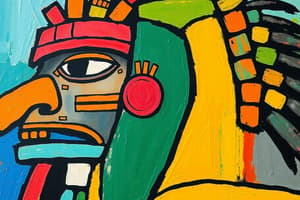Podcast
Questions and Answers
Which of the following civilizations is NOT considered part of the 'New World'?
Which of the following civilizations is NOT considered part of the 'New World'?
- Aztecs (correct)
- Olmecs
- Mayans
- Incas
What is the main theory presented by Jared Diamond in 'Guns, Germs, and Steel'?
What is the main theory presented by Jared Diamond in 'Guns, Germs, and Steel'?
- The New World had superior technology to conquer the Old World.
- The Old World's geographical advantages led to their dominance over the New World. (correct)
- The Old World lacked the resources to effectively conquer the New World.
- The New World's isolation led to cultural stagnation and prevented their advance.
Which of these languages is NOT a Romance language?
Which of these languages is NOT a Romance language?
- Romanian
- Spanish
- Portuguese
- German (correct)
Which of these religions is NOT monotheistic?
Which of these religions is NOT monotheistic?
Which of these European languages is NOT derived from the Cyrillic alphabet?
Which of these European languages is NOT derived from the Cyrillic alphabet?
Flashcards
Olmecs
Olmecs
An ancient civilization in Mexico, known for their colossal heads and influence on later cultures.
Colombian Exchange
Colombian Exchange
The widespread transfer of animal, plants, culture, human populations, and more between the Americas and the Old World.
Monotheistic Religions
Monotheistic Religions
Religions that believe in a single deity; includes Christianity, Islam, and Judaism.
Slavic Languages
Slavic Languages
Signup and view all the flashcards
European Languages Family
European Languages Family
Signup and view all the flashcards
Study Notes
Olmecs, Incas, Mayans, Aztecs
- Olmecs, Incas, Mayans, and Aztecs were prominent civilizations in the Americas.
- Each civilization developed unique cultures, social structures, and advancements in areas like agriculture, architecture, and art.
Old World vs. New World
- The "Old World" refers to Eurasia and Africa, and the "New World" refers to the Americas.
- The differences in the environment, resources and the biological makeup of plants and animals played a key role in driving the course of developments in the two hemispheres.
- The Columbian exchange, a transfer of plants, animals, diseases, and ideas between the Old and New Worlds, significantly impacted both continents.
Guns, Germs, and Steel
- This theory posits that the Old World's environmental and geographic advantages (e.g., the availability of certain plants and animals) led to earlier development of agriculture and technology.
- This, coupled with disease resistance and the ability to mobilize resources for warfare, allowed Old World civilizations to conquer the New World.
Colombian Exchange
- The exchange involved the transfer of crops, domestic animals, and diseases between the Old and New Worlds.
- The exchange had profound consequences, altering agriculture, demographics, and economies for both hemispheres.
Quebec Independence Movement
- A political movement advocating for Quebec's separation from Canada.
Top 3 Religions in Europe
- Christianity, Islam, and Judaism
European Languages
- Slavic Languages: Examples include Russian, Polish, Ukrainian, and Czech. These languages derive from the Cyrillic alphabet.
- Romance Languages: Examples include Italian, French, Spanish, Portuguese, and Romanian. They are derived from Latin.
- Germanic Languages: Examples include English, Dutch, and German.
Religions in Detail
- Christianity: A monotheistic religion based on the life and teachings of Jesus Christ. Christian scripture includes the Bible.
- Islam: A monotheistic religion centered on the teachings of the Prophet Muhammad. Islam's holy book is the Quran.
- Judaism: A monotheistic religion that emphasizes the covenant between God and the Jewish people. Its holy book is the Torah.
Studying That Suits You
Use AI to generate personalized quizzes and flashcards to suit your learning preferences.




